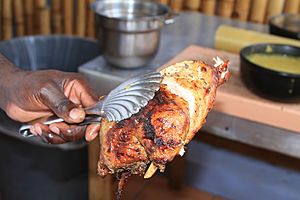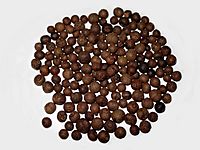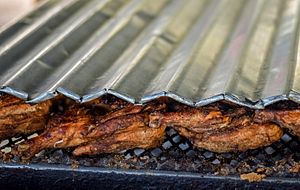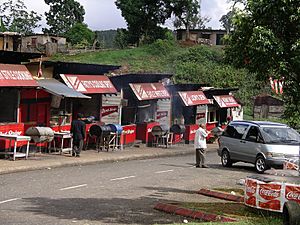Jerk (cooking) facts for kids
Jerk is a special way of cooking that comes from Jamaica. It involves rubbing or soaking meat in a super tasty and often spicy mix of spices called Jamaican jerk spice. This cooking style gives food a unique smoky flavor.
The idea of jerking food started a long time ago with the Amerindian people in Jamaica. These included the Arawak and Taíno tribes. Later, they mixed with a group called the Maroons, who also learned this cooking method.
Jerked meat usually means chicken or pork. The main spices in the jerk sauce are allspice and Scotch bonnet peppers. Jerk cooking is very popular in Caribbean communities around the world, especially in North America and Europe.
Contents
What Does "Jerk" Mean?
The word jerk might come from the Spanish word charqui. This word was used for dried meat and is where the English word jerky comes from.
The term jerk spice is also known as Jamaican jerk spice. It refers to the special mix of spices used. The word jerk can mean the spice rub, the wet sauce, and the cooking method itself. Jerk cooking is now enjoyed all over the world, especially in big cities in America, Canada, and Europe.
How Jerk Cooking Started
Historians believe that the Taíno people first cooked jerked meat. In 1655, when Spain took over Jamaica, the Spanish freed their enslaved Africans. These people ran away into the countryside of Jamaica. They met and mixed with the remaining Taínos, becoming some of the first Jamaican Maroons.
It seems these runaway slaves learned the jerk cooking method from the Taíno people. They cooked meat in underground pits. This was a clever way to avoid making smoke, which would have shown their hiding spots. It's thought that the Taíno developed this cooking and seasoning style.
In the 1600s, everyone in Jamaica hunted wild hogs and used jerk cooking. But by the late 1700s, most groups started using pork that was brought in from other places. Only the Maroons kept hunting wild hogs and jerking the pork.
Jamaican jerk sauce mainly grew from these Maroons. They seasoned and slow-cooked wild hogs over pimento wood. This wood was native to Jamaica and is very important for the taste. Over many years, other cultures added their own ideas, changing the recipe a bit.
The Maroons had to use what was around them in Jamaica. They used local herbs and spices like the Scotch bonnet pepper. This pepper is a big reason why Caribbean jerk is so spicy!
Jerk cooking has traveled with Caribbean people all over the world. You can now find jerk dishes in restaurants almost anywhere there are many people of Caribbean heritage. This includes places like the United Kingdom, Canada, and the United States. A dish called poulet boucané (smoked chicken) in French Caribbean countries like Martinique is quite similar to traditional Jamaican jerk chicken.
How Jerk is Cooked
The way jerk is cooked has changed over time. It started with cooking in pits in the ground. Later, people began using halves of old oil barrels. Around the 1960s, clever Caribbean cooks found a way to cut oil barrels in half lengthwise. They added hinges and drilled holes for smoke.
These barrel grills use charcoal, which makes the food taste even spicier and smokier. If barrels aren't available, other ways of smoking meat, like wood-burning ovens, can be used. However, oil barrels are still one of the most popular ways to make jerk in Jamaica. Today, much of the jerk in Jamaica is grilled over charcoal in a steel drum called a "jerk pan."
You can often find "jerk stands" or "jerk centers" on the streets in Jamaica and the nearby Cayman Islands. They are also common where Caribbean people live around the world. At these stands, you can buy jerked meat, usually chicken or pork. It often comes with hard dough bread, fried cassava bammy (a flatbread), Jamaican fried dumplings (also called "Johnnycake"), and festival (a sweet fried dumpling).
What's in Jerk Seasoning?
Jerk seasoning mainly uses allspice and Scotch bonnet peppers. Other ingredients can include cloves, cinnamon, scallions, nutmeg, thyme, garlic, brown sugar, ginger, soy sauce, and salt.
What Foods Use Jerk Seasoning?
Jerk seasoning was first used on chicken and pork. But today, people use it on many other foods. This includes tofu, fish, shrimp, shellfish, beef, sausage, lamb, goat, and even vegetables.
See also
 In Spanish: Jerk (gastronomía) para niños
In Spanish: Jerk (gastronomía) para niños






